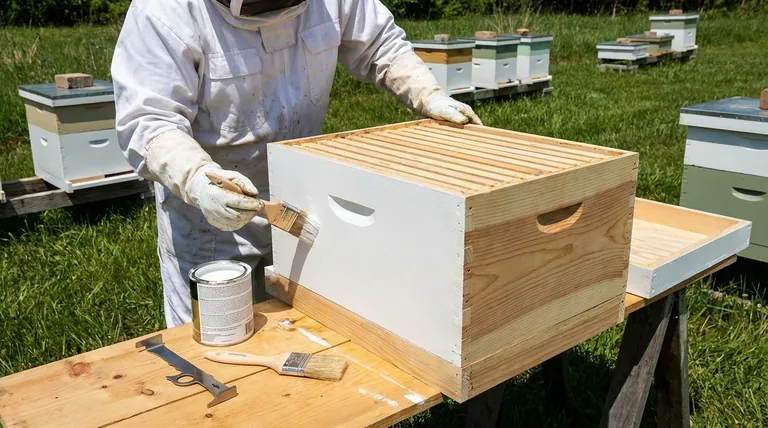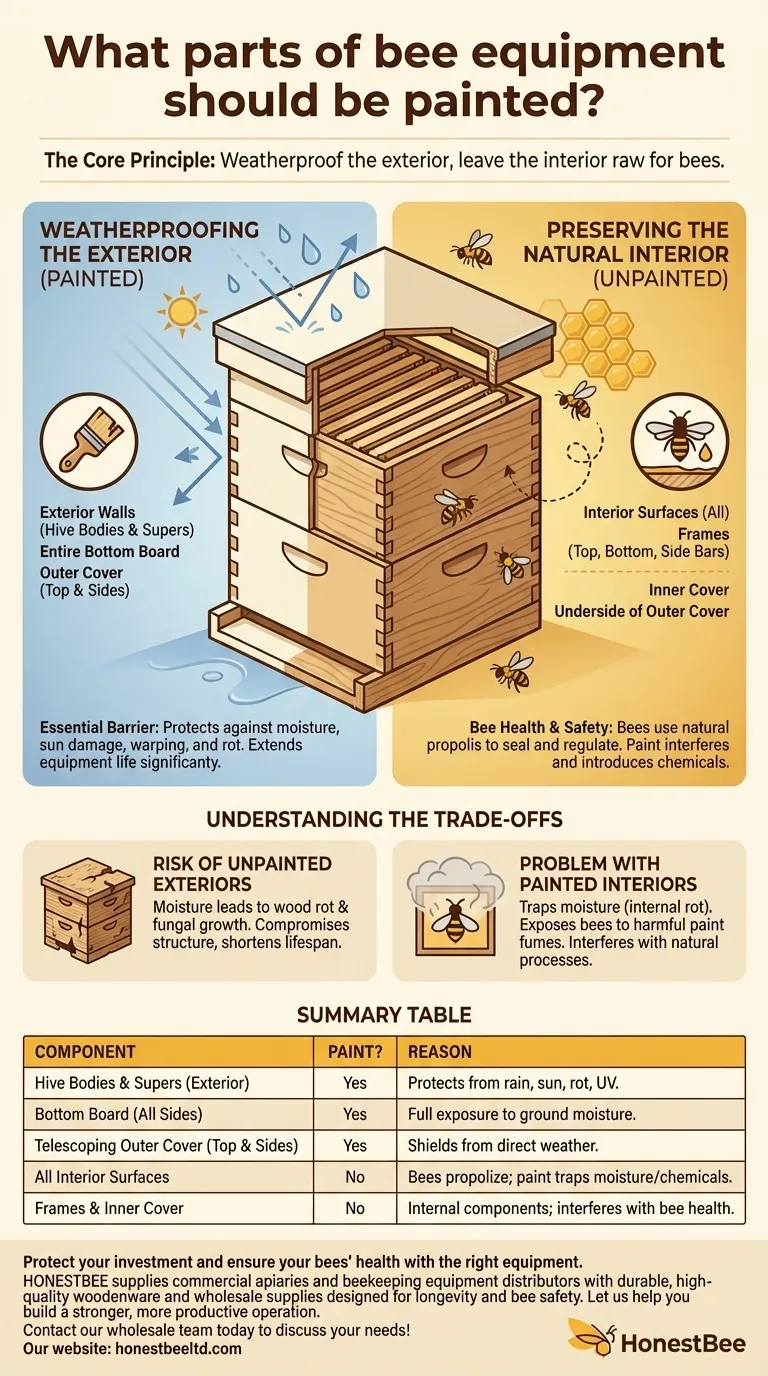When setting up new bee equipment, the fundamental rule is to paint any wooden component that will be exposed to the elements. You should paint all exterior surfaces, including the hive bodies, supers, bottom board, and the top and sides of the outer cover. Conversely, you must leave all interior surfaces, frames, and the inner cover unpainted to protect the health of the bees.
The core strategy is to create a weatherproof exterior shield while maintaining a raw, natural wood interior. The simple guiding principle is: if rain and sun can hit it, paint it; if it's inside the hive, leave it bare for the bees.

The Core Principle: Weatherproofing the Exterior
Protecting your wooden hive components from the environment is the single most important factor in ensuring their longevity. Paint serves as a critical barrier against moisture and sun damage.
Why Painting is Essential
Unprotected wood exposed to rain and sun will quickly begin to warp, crack, and rot. A proper coat of exterior paint acts as a shield, reflecting UV rays and preventing water from soaking into the grain.
This simple step can extend the life of your equipment from just a few seasons to a decade or more, protecting your financial investment.
What to Paint: A Component Checklist
You should apply at least two coats of high-quality, exterior-grade paint to every part that faces the outdoors.
This includes the exterior walls of all hive bodies and supers, the entire bottom board (top, bottom, and sides), and the top and sides of the telescoping outer cover.
Preserving the Natural Interior
While the outside needs protection, the inside of the hive is the bees' living space. Keeping it free of artificial materials is crucial for the colony's health and natural behavior.
Why the Inside Remains Unpainted
Interior surfaces are not exposed to rain and sun, so painting them provides no practical benefit for wood preservation.
More importantly, bees manage their own interior environment. They coat the walls with propolis, a resinous substance that has antimicrobial properties and helps regulate the hive. Paint interferes with this natural process and can introduce chemicals into their enclosed living space.
What NOT to Paint: An Exclusion List
To ensure a healthy environment, never apply paint or sealant to these components:
- The inside surfaces of all hive bodies and supers.
- All parts of the frames, including the top, bottom, and side bars.
- The inner cover.
- The underside of the telescoping outer cover.
Understanding the Trade-offs
Making the right choice is about balancing equipment protection with the needs of the colony. The consequences of deviating from these best practices are clear.
The Risk of Unpainted Exteriors
Leaving exterior wood untreated is the fastest way to destroy your equipment. Moisture will lead directly to wood rot and fungal growth, compromising the structural integrity of the hive and drastically reducing its usable lifespan.
The Problem with Painting Interiors
Painting the inside of a hive can trap moisture within the wood, potentially leading to rot from the inside out. More critically, it exposes the colony to paint fumes and chemicals, which can be harmful or fatal in a poorly ventilated space. It also creates a surface bees cannot properly manage with propolis.
Making the Right Choice for Your Hive
Applying these principles correctly is straightforward. Your approach should be guided by the dual goals of protecting your gear and your bees.
- If your primary focus is equipment longevity: Prioritize applying at least two coats of a light-colored exterior latex paint to all outside surfaces before they are ever exposed to weather.
- If your primary focus is bee health and safety: Strictly avoid painting any interior surface, allowing the bees to seal and manage their own environment with natural propolis.
By following this simple exterior-only rule, you ensure both a long-lasting hive and a healthy home for your colony.
Summary Table:
| Component | Paint? | Reason |
|---|---|---|
| Hive Bodies & Supers (Exterior) | Yes | Protects wood from rain, sun, rot, and UV damage. |
| Bottom Board (All Sides) | Yes | Full exposure to ground moisture requires complete protection. |
| Telescoping Outer Cover (Top & Sides) | Yes | Shields the hive's top from direct weather. |
| All Interior Surfaces | No | Bees propolize these surfaces; paint can trap moisture and chemicals. |
| Frames & Inner Cover | No | These are internal components; painting interferes with bee health. |
Protect your investment and ensure your bees' health with the right equipment. HONESTBEE supplies commercial apiaries and beekeeping equipment distributors with durable, high-quality woodenware and wholesale supplies designed for longevity and bee safety. Let us help you build a stronger, more productive operation. Contact our wholesale team today to discuss your needs!
Visual Guide

Related Products
- HONESTBEE Advanced Ergonomic Stainless Steel Hive Tool for Beekeeping
- Professional Dual-End Stainless Steel Hive Tool for Beekeeping
- Professional 3-Bar Frame Grip with Integrated Hive Tool
- Professional Drop-Style Hive Handles for Beekeeping
- Wholesales Dadant Size Wooden Bee Hives for Beekeeping
People Also Ask
- What are some common uses of a hive tool? Essential Multi-Purpose Tool for Every Beekeeper
- Why do hive tools have a hole? Unlock the Secret to Efficient Beekeeping
- How is a hive tool used for scraping and cleaning? Master Hive Maintenance for a Healthy Colony
- How should beekeepers handle bees when using a hive tool? Master Calm, Deliberate Techniques
- What is a hive tool and what are its uses? Master Your Hive Inspections with the Essential Beekeeper's Tool



















